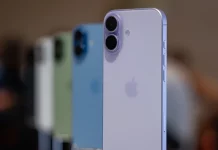Battery life has been a top priority for Apple in recent years, and the iPhone 17 series exemplifies these efforts. Battery tests reveal that the iPhone 17 Pro Max outperforms many of its main competitors in longevity, while the iPhone Air manages to last a full day despite its ultra-thin design. While future iPhone models are expected to see further improvements in battery life, Apple is exploring innovative ways to achieve this goal beyond merely increasing battery capacity.
A recent report from Korean outlet ETNews indicates that Apple is developing a groundbreaking display technology that could significantly boost battery efficiency or enable the inclusion of more power-demanding features, such as enhanced on-device AI capabilities, without compromising battery life.
Introducing High Mobility Oxide (HMO) Technology
This new display tech is called High Mobility Oxide (HMO), and it aims to replace the current high-resolution, high-refresh-rate LTPO panels used in iPhones. Apple first incorporated LTPO technology in the Apple Watch Series 4 in 2018 and introduced it in the iPhone 14 Pro models in 2022. LTPO allows for dynamic refresh rates ranging from 1Hz to 120Hz (ProMotion), enabling smartphones to adapt their refresh rate based on content, which improves battery efficiency compared to the previous LTPS technology.
A display expert informed ETNews that HMO is a relatively new technology, gaining attention among scientists only in recent years. Although LTPO, a technology that Apple helped develop, still dominates the small and medium OLED market, industry insiders believe that if Apple invests heavily in HMO and refines it further, the landscape could shift dramatically. Interestingly, Apple applied for its first LTPO patent back in 2014—years before the technology became commercially available.
Benefits of HMO for the iPhone
ETNews explains that HMO focuses on the thin-film transistor (TFT) layer responsible for controlling current flow to the OLED pixels. Apple’s goal is to improve electron mobility within HMO TFTs—an area where oxide TFTs currently face limitations. While oxide TFTs are power-efficient, their lower electron mobility restricts higher resolutions and faster refresh rates.
An HMO OLED display could enable the iPhone to conserve battery life without sacrificing image quality, whether in terms of brightness, resolution, or refresh rate. This advancement might allow Apple to extend battery life without increasing battery capacity, thereby maintaining sleek, compact designs. Alternatively, the energy savings could power new features that are currently constrained by power limitations. Moreover, HMO technology promises lower production costs compared to LTPO, which could help Apple curb manufacturing expenses amid rising costs for other components.
Industry Collaboration and Future Plans
Apple is reportedly engaging with Korean display vendors—most likely Samsung Display and LG Display, both of which already supply screens for iPhones and other Apple gadgets—to manufacture HMO panels. Although Apple has not officially announced a timeline, industry expert Ross Young suggests that mass production of HMO screens could begin as early as next year. He further confirms that HMO technology is well-established and that Samsung, in particular, plans to produce HMO displays for the IT sector in the near future.





